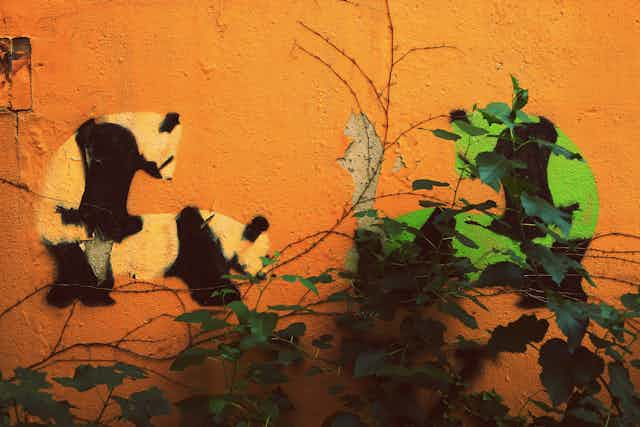I felt like putting a bullet between the eyes of every panda that wouldn’t screw to save its species – “Narrator”, Fight Club
Though Edward Norton’s unnamed movie character was no conservation biologist he was actually pretty close to the solution. Giant pandas don’t choose not to “screw” out of spite, of course, or because they have no natural urge to reproduce – in the wild they have perfectly good sex drives.
However, just as Tyler Durden and co felt they needed to turn to violence in order to find meaning in their lives, so it is becoming apparent that male pandas also need to fight – in order to mate. To save their species, captive pandas may need a fight club of their own.
The breeding problems are particularly apparent in Edinburgh, where the zoo has announced once again that its female giant panda Tian Tian has conceived through artificial insemination, but is not yet pregnant. That is, a sperm has entered an egg, which has been placed inside her; but crucially this fertilised egg has not yet implanted. Unfortunately, these attempts at artificial reproduction often don’t work.
Some scientists say giant pandas are so hard to breed that they shouldn’t even exist in nature. Females often don’t accept males, and even if a female is interested in a male this sexual interest is not reciprocated.
None of this makes sense. The meaning of life, as all biologists know, is passing your genes on to the future and to do this you need to mate. But we have arrived at our conclusions on panda reproduction based on our observations of zoo-housed giant pandas and not from data on wild individuals. I suspect herein lies the problem – zoos don’t offer the same sexual opportunities as life in the wild.

The panda situation reminds me of another species, which despite being held in captivity for thousands of years had only bred once before the 1950s: the cheetah. Now the captive cheetah population is growing rapidly. To understand how zoos have solved this problem with cheetahs and where the problem with giant pandas comes from we need to look back in time.
Nuclear animal families?
The first modern zoo, in London, was founded in the Victorian era, a time when animal collectors had no qualms about going around the world to gather new species by any means necessary. The animals were housed in a monogamous family unit, in accordance with Victorian standards of morality. Even today zoo visitors explain to their children which animal is the mummy or the daddy and any inconvenient other adults are explained away as aunties or uncles. This situation has been reinforced by zoos describing themselves as modern arks, creating the image of animals entering two-by-two.

But once scientists started to study animals in the wild it quickly became obvious that monogamy is not the norm. And even in species that are monogamous there is considerable mate choice or, to be more accurate, reproductive partners are chosen by females. Just like humans, most animals chose their reproductive partners according to their strength and good looks, or the resources they control, as these characteristics affect the perpetuation of their genes.
Captive female cheetahs finally started breeding once they were offered a range of suitors rather than being housed with just one male. This replicated their behaviour in the wild, where female cheetahs like to give several males the once over before choosing who to breed with. It may be that the first male that caught the female’s eye will be the one that she will eventually choose, but confirming he is the best available in the breeding pool seems to be crucial. Zoos who imitate this situation are successful at breeding cheetahs.
Giant pandas are no longer housed in pairs. Instead, males and females are typically kept in adjacent enclosures and the male is introduced to the female during the one to three days a year when she is fertile. But it is just one male. What if he is ugly? Or maybe the female panda wishes suitors would strut their stuff on a mating catwalk, like cheetahs do.
Perhaps males need to impress females with shows of strength, by beating up or chasing off other males. It could also be that males need some competition to put them in the mood – studies of wild pandas show their testosterone levels are low except at mating time.
Female giant pandas advertise their readiness to breed by scent marking around the edges of their territory, leading to the simultaneous arrival of several males who will chase off or beat-up their competition until only the strongest remains. So, the victor gets the opportunity to propagate its genes.
If all of this is correct it suggests zoos wanting to move away from artificial reproduction might be better off instead focusing on panda fight clubs. Alternatively, it may be possible to dupe females into believing certain males are worthy suitors as has been done with pygmy lorises by making them appear to be winners of fights.

